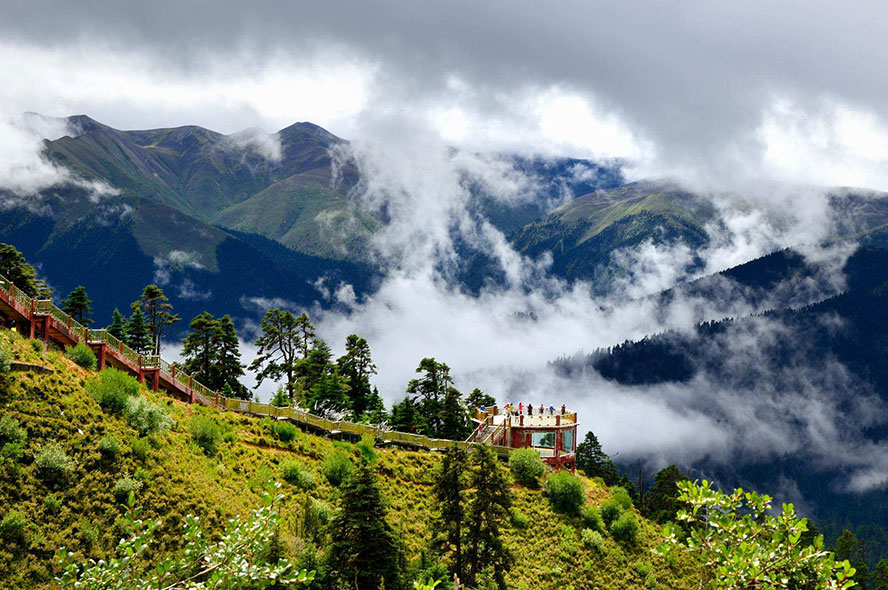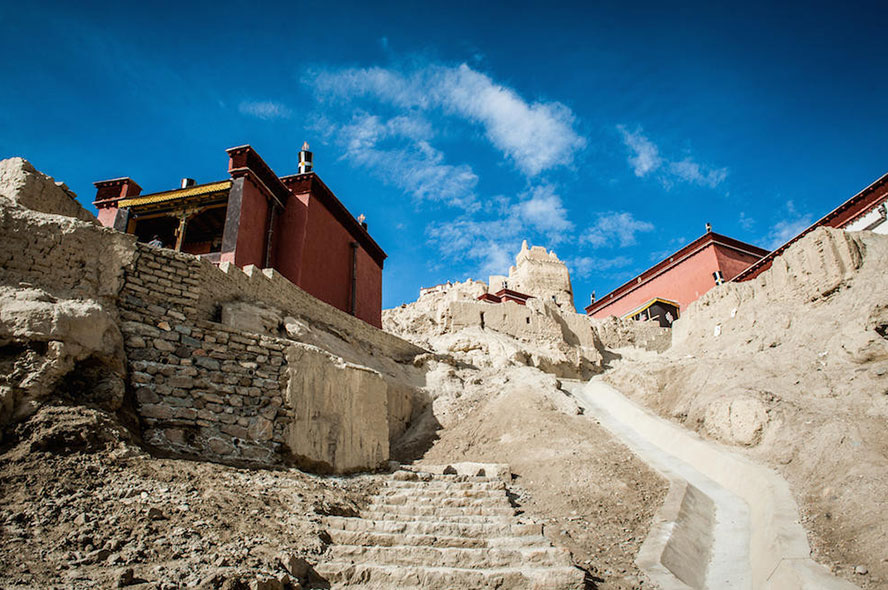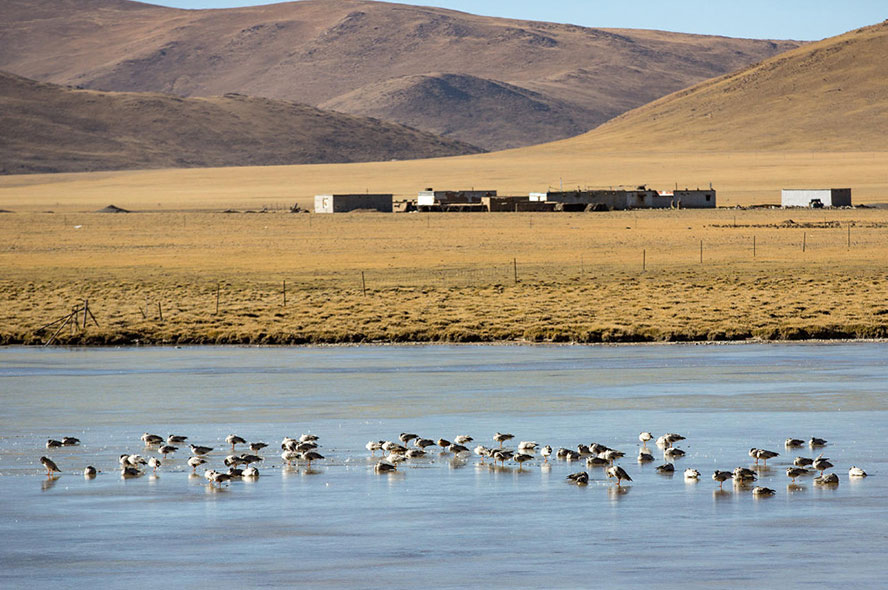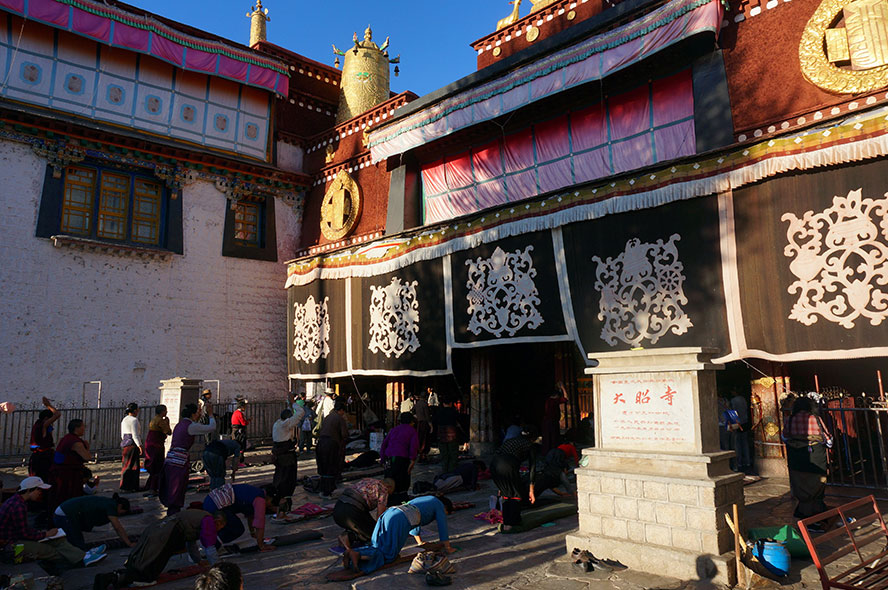Unlike January, although the weather in February in Tibet is cold and dry, visitors still can have a lot of chances to enjoy warm sunshine in daytime (the temperature can increase up to over 10 degrees Celsius). Yet it is relatively chilly at night, with the temperature dropping to as low as -8 degrees Celsius. It snows but seldom rains during this period in most places of the region. Besides, it is also windy and fiercely frigid in February.
As the last month of winter, February would definitely be a pleasant time to visit Tibet. It is commonly believed that Tibet in winter is more freezing than other cities in China. However, in spite of the heavy snow, the weather in southern and central Tibet is kind of warmer than inland cities, as there is always warm sunshine during daytime in winter. Because of the clear sky as well as the fresh air, visitors can enjoy great views of mountain peaks better.
Blue sky in Tibet in February
Overall Tibet climate in February
- Average Minimum Temperature: -8 ℃ (17.6ºF)
- Average Maximum Temperature: 15 ℃ (59ºF)
- Tibet Average Temperature: 3.5 ℃ (38.3ºF)
- Average Precipitation/Rainfall: 1 mm (0.039 in)
- Wet Days (>0.1mm): 1
- Relative Humidity: 27%
Most-Visited Places in Tibet along the way from Lhasa to Kathmandu via Overland in February
Winter lasts particularly long in Tibet. Although February is the last month of winter here, the wind during this period remains bleak. Visitors may worry about the weather in this period in Tibet. However, there is no need for them to worry so much about that, as they can still visit most of the places in Tibet in February. Sunny days are dominated weather in February on the places of Qinghai-Tibet Plateau, so visitors can go to visit tourist attractions like Lhasa and Shigatse during this period.
Roads to natural scenic spots like Ngari, Nagchu, and Namtso Lake will be blocked by heavy snows in winter. There are still many places that visitors can pay a visit to, such as Lhasa, Shannan, and Nyingchi. For visitors who go to Tibet in February, they can have the chance to join with the Tibetans to celebrate the most significant festival during their stay in Tibet — the Tibetan New Year.
Lhasa Tibet Climate in February
- Average Minimum Temperature: -6 ℃ (21.2ºF)
- Average Maximum Temperature: 9 ℃ (48.2ºF)
- Average Precipitation/Rainfall: 1 mm (0.039 in)
- Rainy Days: 1
- Relative Humidity: 26 %
- Average Wind Speed: 13.6km/h (8.5 mi/h)
Similar to the weather in January, weather in February in Lhasa is dry and cold. It is often windy there as well. And the wind in the outskirts is much stronger than the wind in downtown area. Temperature differences in early February and late February only vary slightly. In early February, the temperature ranges from -8 to 8 degrees Celsius, and in late February, the temperature ranges from -5 to 12 degrees Celsius. Due to the full sunshine, it is usually warm in daytime, while the temperature can drop dramatically at night because of the clear sky and thin air.
Potala Palace in February
Visiting Lhasa in February is quite pleasant as visitors don’t need to wear clothes of multiple layers while travelling there. One reason is that the sunlight is bright in daytime. The other reason is that visitors have to do a lot of walking and climbing there, which will undoubtedly keep them warm. To enjoy the scenery better, they will have to walk and climb to monasteries like Jokhang Temple, Sera Monastery and Potala Palace etc.
When you walk on the streets in Lhasa in February, you will see all local people wearing thick Tibetan clothes and tourists wearing down coats. If you are cold-resistant, you can just wear a sweater plus a jacket. Or else a down coat is definitely necessary. It would be fine not to button up the coat when you are in the urban area of Lhasa, because you need to walk all the way to visit the monasteries and palaces in Lhasa, and exercise can generate heat inside your body. In this way, you will feel warm while visiting the attractions in Lhasa.
Namtso Tibet Climate in February
- Average Minimum Temperature: -7 ℃ (19.4ºF)
- Average Maximum Temperature: 9 ℃ (48.2ºF)
- Average Precipitation/Rainfall: 0
- Rainy Days: 1
Namtso Lake is one of the most popular attractions for tourists travelling in Tibet. In Tibetan language, Namtso means “Heavenly Lake”. It is the largest saltwater lake in Tibet and the second largest lake in China (only after Qinghai Lake). Because of the high altitude and the special geographical location, Namtso Lake owns a special weather and climate, featuring with much of wind, strong sunlight, and heavy snow in winter. Therefore, Namtso is rather chilly during this period. One thing that disappointed visitors the most is that owing to the frozen lake and the closed mountain pass, roads to Namtso Lake is inaccessible in February.
The wind is strong and cold in Namtso in January, so thermal clothes is essential for a trip to Namtso during this period. In addition, gloves, scarves, hats and cold-weather masks will be much useful to against the strong wind in Namtso. When the temperature is below -15 degrees Celsius at night, you should stay in hotels to keep out the cold. Hotels in Damxung County, the country where Namtso located, may be poor in terms of heating facilities, so you need to wear thick clothes to keep warm even when you are in the hotels.
Nyingchi Tibet Climate in February
- Average Minimum Temperature: -3 ℃ (26.6ºF)
- Average Maximum Temperature: 10 ℃ (50ºF)
- Average Precipitation/Rainfall: 5 mm (0.2 in)
- Rainy Days: 6
Nyingchi is a prefecture lying in the southeastern area of Tibet. When February comes, the weather in Nyingchi gets warmer, with an average temperature ranging from -3 to 10 degrees Celsius, which is milder than that of Beijing (about -4 to 6 degrees Celsius). It only snow slightly during the period. In Tibetan language, Nyingchi means “the Throne of Sun”. Nyingchi was given the name because of its special location. Compared with other areas in Tibet, Nyingchi is the place where the whole process of sun rise can be seen clearly. People who go to Nyingchi shouldn’t miss Ranwu Lake, a major tourist attraction of the prefecture. The snow-capped mountains and other sightseeing around can be reflected by the blue and limpid water, making the whole scenery an impressive and picturesque one.
Although Nyingchi is relatively warm in February, temperature difference between day and night is still large. Thermal clothes such as down coats, fleece jackets and sweaters are necessary to against the cold in the morning and at night.
Shannan Tibet Climate in February
- Average Minimum Temperature: -12 ℃ (10.4ºF)
- Average Maximum Temperature: 10 ℃ (50ºF)
- Average Precipitation/Rainfall: 0 mm
It would be a good choice to visit Shannan in February, when the average temperature in daytime reaches around 10 degrees Celsius. However, the temperature at night can drop to as low as -12 degrees Celsius. So visitors had better bring with them thick clothes before travelling there. Yumbulagang Palace is a place that visitors should pay a visit to during their stay in Shannan. It is the first palace in Tibet built by the first Tibetan King, Nyatri Tsanpo, in more than 2100 years ago. After that, visitors can then enjoy the picturesque landscape of rich valley and plat land while driving along the riverside of the Yarlung Zangbo River, the highest major river in the world. Just like a sliver dragon, Yarlung Zangbo River runs from the Himalaya Mountains, breaks through the barriers and bends on the highest plateau of the world—Qinghai-Tibet Plateau, and then flows into the Bay of Bengal.
The best clothing choice for a trip to Shannan in winter would be the followings: sweater + thick coat (a down coat would be better) + thick pants. Your shoes must have good warmth-retention property to keep your feet warm, and your underwear should be made of pure cotton. In addition, gloves, hats and scarves are also good equipment to keep out the cold, so don’t forget to bring them if there is still room in your bag.
Yamdrok Lake Tibet Climate in February
- Average Minimum Temperature: -11 ℃ (12.2ºF)
- Average Maximum Temperature: 4 ℃ (39.2ºF)
- Average Precipitation/Rainfall: 1 mm (0.039 in)
Yamdrok Lake, known as the "Coral Lake" because of its coral-like convoluted shape, is a one of the popular places in Shannnan. It is located at an altitude of about 4,441meters and is one of the three holy lakes in Tibet (together with Namtso Lake and Lake Manasarovar). Situated at the south of Yarlong Tsangpo River in Shannan, the lake is surrounded by many snow-capped mountains. Standing on the tops of hills, visitors can have a far view of the fresh water of Yamdrok Lake under the sunshine. The lake will be half-frozen in winter months. In February, even though the temperature here can drop to below -10 degrees Celsius, the lake is still accessible. Besides, the place is less crowded during this period because of the cold weather, making the place a more tranquil and peaceful one.
When there is sunshine in daytime, you can just wear a sweater plus a fleece jacket. You need to put on extra thermal underwear inside to keep out the cold when there is no sunshine during daytime. In addition, as the temperature difference between day and night can be pretty low, you must pay attention to keep your feet warm at this time.
Gyantse Tibet Climate in February
- Average Minimum Temperature: -11.8 ℃ (10.76ºF)
- Average Maximum Temperature: 7.6 ℃ (45.68ºF)
- Average Precipitation/Rainfall: 0.4 mm (0.015 in)
- Rainy Days: 0
- Relative Humidity: 33%
Visitors can make a stop at Gyantse while travelling from Lhasa to Shigatse or to the remote western areas in Tibet. Gyantse is located at an altitude of around 4,000 meters, a little higher than that of Lhasa (about 3,650 meters). It enjoys a plateau monsoon climate because of the high altitude, featuring with sufficient sunshine, small yearly temperature difference and huge temperature difference between day and night in winter.
Although the weather in Gyanste in February is cold, it is a little warmer than the weather in January. The temperature is proper and the weather is always nice during the period. So it is a good choice to pay a visit to the historic monasteries and cultural sites such as the renowned the Kumbum Monastery, which is the only monastery in Tibet that harmoniously housed monks of different sects. Kumbum Monastery is also a typical example of Tibetan Buddhism temple in terms of architecture, representing a typical style of temples from thirteenth century to fifteenth century in Tibet.
Because of the sufficient sunshine, the temperature in Gyantse in daytime maintains at around 10 degrees Celsius. When it comes to evenings, the temperature will drop down to below zero degree, so you need to prepare thick and thermal clothes to keep warm at night.
Shigatse Tibet Climate in February
- Average Minimum Temperature: -9.2 ℃ (15.44ºF)
- Average Maximum Temperature: 8.41 ℃ (47.1ºF)
- Average Precipitation/Rainfall: 0.16 mm (0.006 in)
- Rainy Days: 2
- Relative Humidity: 23 %
- Average Wind Speed: 5.9 km/h (3.7 mi/h)
As the last month of winter, February witnesses a slightly increasing temperature in Shigatse. Weather in daytime here is warmer than what people have expected, as the highest temperature can reach to as high as 16 degrees Celsius. While the temperature at night can drop to as low as -13 degrees Celsius. There is also strong wind in February, making the month the driest time of the year in Shigatse.
There is always sunshine in Shigatse in February and the sunshine usually lasts for about 8 hours on sunny days. So Shigatse is a comfortable place for tourists to visit during this period. Shigatse boasts the richest tourist resources in Tibet, among which one of the most famous attractions is the magnificent Tashilhunpo Monastery. Founded by the First Dailai Lama in 1447, Tashilhunpo Monastery is one of the six Gelug monasteries as well as the seat of successive Panchen Lamas. Being the largest monastery in Shigatse (nearly 150,000 square meters), Tashilhunpo Monastery stores many treasures. One of the highlights of the monastery would definitely be the future Buddha Statue, which is the largest gold gilded bronze statue in the world.
Shigatse is only about 200 meters higher than Lhasa, so temperature difference between these two places is not very huge. However, as the places between Shigatse and Lhasa are located at pretty high altitude, you still need to bring thermal clothes to keep warm on the way.
The clothes you should wear in Shigatse should be similar to the clothes you wear in Lhasa. But one thing to be noticed is that you need to button up or zip the your coats while you are in Shigatse, as the wind can be strong here because of the high altitude. If you want to take pictures along the way from Lhasa to Shigatse, do put on a hat and scarf before getting off the car. Besides, you shouldn’t stay too long outside the car, because the wind can be so strong that you can’t bear.
EBC Tibet Climate in February
- Average Minimum Temperature: -15 ℃ (5ºF)
- Average Maximum Temperature: 4 ℃ (39.2ºF)
- Average Precipitation/Rainfall: 5 mm (0.2 in)
- Rainy Days: 0.2
- Average Wind Speed: 9 km/h (5.6 mi/h)
In February, the weather in Everest Base Camp region is still cold, with the average temperature ranging from -15 to 4 degrees Celsius. It seldom rains during the period, so the weather there is usually sunny and cloudy. However, the wind can be strong and chilly in Mt. Everest, so a long-time stay in EBC is unacceptable for normal visitors. Besides, the road to EBC will sometimes not open to the public because of the harsh weather.
Although it is dry and frigid in February in EBC, the air this time is the clearest, allowing visitors to enjoy the most incredible view of Mt. Everest. It still snows in February, so don’t forget to bring with you plenty of clothes and objects for warm-keeping before getting EBC.
Please wear as much clothes (thermal under + sweater + fleece jacket + down coat) as possible when you go to EBC in February. You need to wear at least two pants in EBC during this period. Besides, as you won’t walk or exercise too much at EBC, keeping your feet warm is of great importance at this time. And thick socks and thermal boots will be helpful to keep your feet out of the cold.
Mt. Kailash Tibet Climate in February
- Average Minimum Temperature: -27 ℃ (-16.6ºF)
- Average Maximum Temperature: -10 ℃ (14ºF)
- Average Precipitation/Rainfall: 15 mm (0.59 in)
- Rainy Days: 7.9
Even in the last month of the winter, weather in Mount Kailash remains extremely cold, with the lowest temperature dropping to -10 degrees Celsius. Going to the mountain at this time can be dangerous, as the mountain passes and trekking roads are blocked because of the heavy snow. Visitors are recommended to go to visit the mountain from April to October, when the weather is proper and favorable for visiting.
Lhasa to Kathmandu via Overland in February
- Kathmandu Average Minimum Temperature: 4 ℃ (39.2ºF)
- Kathmandu Average Maximum Temperature: 19 ℃ (66.2ºF)
- Kathmandu Average Precipitation/Rainfall: 14 mm (0.55 in)
- Kathmandu Rainy Days: 5
- Kathmandu Relative Humidity: 53 %
- Kathmandu Average Wind Speed: 2.9 km/h (1.8 mi/h)
- Gyirong Port Average Minimum Temperature: 4 ℃ (39.2ºF)
- Gyirong Port Average Maximum Temperature: -5℃ (23ºF)
Just as it is the last winter month in Tibet, February is also the last month of winter in Kathmandu. Weather condition in February is very similar to that of the January: cool in daytime and cold at night. Sunshine will normally last for about 5 to 7 hours during daytime, so it is relatively comfortable to visit Kathmandu in February.
While driving from Lhasa to Kathmandu via the Friendship Highway, visitors need to pass through Gyirong Port, an overland gateway from Tibet to Nepal. Although the road condition in February is quite suitable for driving, visitors still need to be careful as the road can be slippery sometimes because of the snow.
Tips:
For visitors who want to travel from Kathmandu to Lhasa via overland, they will have to apply for both the Tibet Permit and China Group Visa in Kathmandu, otherwise they won’t be able to visit Lhasa, Shigatse and other areas of Tibet. With the help of our staff, visitors can get their documents done quickly. One thing to remember is that visitors have to apply for the visa at least 3 days before their tour starts, as it will take 3 working days to finish the process. After handing in the passports, out travel consultants will help you get all the details done.
Tibetan Festivals in February
Tibetan New Year Festival, also known as Losar Festival, is the most significant festival in Tibet. It was inscribed on the Third Batch of National Intangible Cultural Heritage List under the approval of the State Council in 2011. Just as what its name implies, the Tibetan New Year takes place on the first day of the first month of Tibetan calendar. However, as major celebration of the festival will be held on the first 3 days, so Tibetans usually begin to celebrate the festival from December 29th and the festival will last for about 2 weeks. Tibetan New Year not only offers Tibetans a great opportunity to get together and have a big dinner, but also offers chances for tourists to join with them to celebrate the festival and know more about traditional Tibetan culture. Ancient ceremonies which represent the struggle between good and evil will be held to celebrate the festival. One of the ceremonies is that Lamas will chant and pass fire torches through the crowds.
Singing and dancing are definitely on the list of Tibetan New Year celebration. Besides, eating Guthuk (barley crumb food with fillings) on New Year's Eve with family members is also one of the traditional celebration activities. Eating Guthuk is fun since the barley crumbs will be stuffed with different fillings such as peppers, stones, fleece, and coins to fool other family members. After dinner, the activity of banishing evil spirits will be observed. People will make a witch and two bowls out of roasted barley flour. And then a women will take the bowls and the witch outside the house and burn them after putting the left Guthuk and food residue in the bowls. At the same time, children will set off firecrackers to frighten devils away. Tibetans begin to visit relatives and friends on the second day of New Year, which will last three to five days. Another activity is that pine branches will be burned to worship mountains gods.
The Great Prayer Festival, also known as Monlam Prayer Festival, is the grandest religious event in Tibet. It falls on the 4th to 11th day of January of Tibetan calendar. The event was firstly held in 1049 by Tsong Khapa, the founder of the Dalai Lama. When the festival comes, religious dances will be performed and thousands of monks will gather in front of Jokhang Temple to chant and celebrate the festival.
The Butter Lamp Festival, which is called “Chunga Choepa” in Tibetan language, falls on the 15th day of the first Tibetan month. The event was also firstly held by Tsong Khapa, the founder of the Dalai Lama. When the festival comes, giant butter lamps of different symbols and figures with lucky connotations will be displayed on Barkhor Street, making the street a miraculous and beautiful world. People will keep singing and dancing the whole night to celebrate the festival.
Recommended Packages for a Tibet Tour in February
The most significant things that visitors must not forget to bring with them before getting to Tibet include passport, Tibet Travel Permit as well as Chinese Visa. Besides, visitors had better not underestimate the coldness in Tibet in February. Even for people who do not generally mind cold weather, clothes like thick sweaters and down jackets that can keep them from coldness are also of great significance, as the temperature in Tibet during this period is not as warm as they think. Others thermal things like gloves, warm shoes, and hats are also necessary for a trip to Tibet in February.
Unless you want to get a great tan during the trip in Tibet, do bring with you sunglasses and sun protection equipment such as sun hats and high SPF sunscreen, as there is intense sunlight during daytime all year round. Besides, skin cream, hand cream and lip balm are also necessary to against the dry weather there.
Oxygen content in winter on the plateau is lower than in summer. Therefore, it is more likely that people will get altitude sickness when they arrive in Tibet in winter. To avoid such situation, visitors had better take Rhodiola 7 to 15 days in advance before they get to Tibet. Medicine like Rhodiola Compound Capsule and Gaoyuan’an that can relieve the symptoms of altitude sickness should also be prepared.
Go or Not?
Most people might think that a journey to Tibet in February is uncomfortable because of the cold weather. However, in spite of the large temperature difference between day and night, weather conditions in Tibet in February are much better than what they think. It is always sunny there. And because of the bright sunshine and little rainfall, it is also very dry in Tibet. So visitors can enjoy a lot from their trip in Tibet in February.
For those who want to have a deeper understanding of the Tibetan Buddhist culture and enjoy more about the beauty of the architectures in Lhasa and Shigatse, February is definitely one of the most suitable time. The amount of visitors to Tibet during this period is the lowest throughout the year, so it won’t be very crowded in February there. Besides, roads to Yamdrok Lake and Mount Everest are open to the public again, so visitors can have the chance to enjoy the stunning beauty of the alpine mountains and lakes in winter.
The Tibetan New Year, the most significant Tibetan festiva, also falls in February. So visitors who go to Tibet in February can get a good chance to celebrate the Tibetan New Year with local people. As February is the low season in Tibet tourism, visitors can also have a contented stay there. They can use the least money to enjoy the worthiest experience during this period.

















































 Data in submission...
Data in submission...